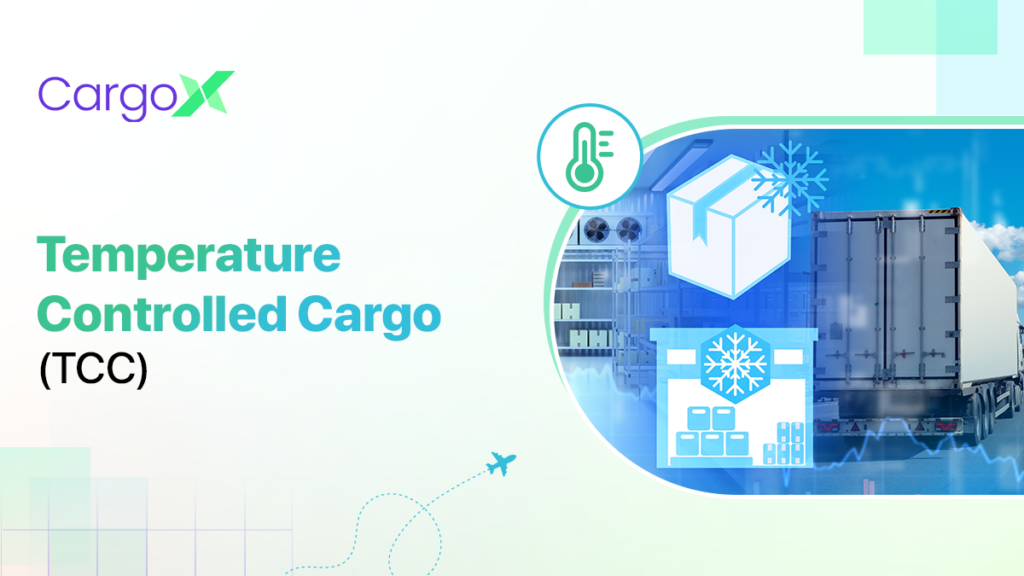Temperature Controlled Cargo (TCC): Smart Operations
Have you ever wondered how delicate items like medicines, fresh produce, or chemicals safely traverse globally? The Temperature Controlled Cargo (TCC) operations help handle such sensitive goods.
The International Air Transport Association (IATA) revolutionized shipping by introducing guidelines to ensure fragile shipments reach customers safely. What started as a small section in the IATA Perishable Goods Regulations (PCR) manual evolved into the Temperature Control Regulations (TCR).
These guidelines are practical and developed with input from leading airlines, airport handling companies, and global organizations like the WHO and FIATA. They help businesses meet the increasing demand for precise and reliable shipping.

How TCC Logistics Ensures Safe Delivery of Sensitive Goods?
TCC handles products like medicines, chemicals, vaccines, and perishables such as fruits, vegetables, dairy, and meat. These items are highly sensitive to temperature changes, requiring specialised logistics and care during transport.
TCC takes into account factors like maintaining the right temperature range, using temperature control and monitoring devices, ensuring proper storage without temperature fluctuations, and managing issues like delays that could affect the quality of the cargo.
The airport warehouse conditions must also be conducive, along with safe ramp and terminal handling operations and the suitable inner conditions of aircraft cargo holds. Every aircraft has different temperature ranges in its cargo compartments.
Knowing all types of specific aircraft configurations is important before deciding which cargo hold (main deck, lower deck, forward, or aft compartment) will transport temperature-sensitive shipments.
Moreover, if the TCC management requires an electrical power supply, the concerned personnel must ensure that all transit points have the optimum voltage and power with compatible connections.
The carrier and ground handling staff are responsible for handling TCC. They must keep a check on the safe temperature point for the cargo. The manufacturer also needs to provide clear instructions about optimal product conditions, which the shipping and airport personnel can easily comprehend.
Packaging Essentials for Safe Temperature-Controlled Shipments
There are two types of TCC packaging: Passive packages and Active shipping systems.
- Passive packages/containers include a combination of insulating materials and cooling agents. With no requirement for outside intervention, these shipping containers only maintain a temperature range for a specific period before expiry. Hence, these TCC packages are a viable option for short trips or a low cargo volume.
- Whereas, active shipping systems are good for air transportation. They utilise large cargo thermostatic containers with internal batteries. Due to their innovative design, they maintain the needed temperature automatically through pre-installed cooling and heating systems (with sensors and fans).
Packaging essentials for shipping temperature-sensitive goods include:
- Insulated containers: These shipping cases secure goods with a protective barrier, deflecting external temperature changes. Insulation, the first layer of thermal protection, reduces the flow of cold or warm air between the inside and outside of the packaging. The shipping industry commonly uses expanded polystyrene (EPS) insulation for food and healthcare products.
- Outer packaging: A rigid outer packaging, including corrugated cardboard boxes or fluted polypropylene, helps keep the payload at the intended temperature. Corrugated cardboard is ideal for single-use packaging, and fluted polypropylene is best applied to multi-use systems.
- Gel packs: The most popular cooling agent in temperature-controlled packaging is gel packs. Most gel packs are non-toxic and safe for use with sensitive products. These packs can sustain various temperatures; thus, they are often used in high-end food shipments and medical and pharmaceutical applications.
- Dry ice: Solidified carbon dioxide or dry ice is non-toxic, highly conducive for perishables transport, and stays extremely cold for a long time. Dry ice is a solid form of carbon dioxide and is more suited for ultra-low temperature needs. It is harmless and sublimates directly into gas, with no liquid waste, which is useful for transporting frozen consumables over large distances. Sometimes, due to its extreme cold (-78.5°C), dry ice requires careful handling and specialised packaging to prevent safety hazards like burns or gas build-up.
- Refrigerants: Refrigerants are crucial for the temperature controllers to work properly and keep the temperature of TCC shipments calibrated so that sensitive products such as food, pharmaceuticals, and biological samples remain undamaged. They work by absorbing and dissipating heat as necessary. PCMs – Ideal temperature range applications (2°C to 8°C for vaccines, etc.), refrigerant gels – Flexible/ Customisable for various applications. When the transits are long, active shipping systems also use chemical refrigerants such as R134a or ammonia in mechanical cooling units to ensure consistent temperatures. In practice, refrigerants are widely utilised by many sectors. The food industry depends on them to deliver frozen treats such as ice cream, and the healthcare sector uses the carriers to move clinical samples and vaccines. Likewise, shipments of chemicals require refrigerants to avoid decomposition while in transport. As logistics change, green and effective refrigerants emerge as eco-friendly options for successful temperature-controlled shipping.
CargoX Solutions for Smarter Temperature-Controlled Logistics
As industries increasingly depend on cold chains for shipping TCC, efficient and reliable TCC logistics are crucial. CargoX is ready to provide the best solutions, advanced technology, and affordable shipping rates.
CargoX is a seamless mix of operational ease and expertise, with a large, competent team of international shipping experts who know how to handle TCC operations.
Its comprehensive cold chain logistics are designed for carrying perishable and other temperature-sensitive goods. With a user-friendly interface and latest features, like a real-time tracking system with live updates, CargoX empowers you to track and monitor your TCC at every step.
Bid goodbye to expensive temperature issues, inventory losses, and customer dissatisfaction. Experience complete peace of mind with efficient cold chain logistics management by CargoX.
Conclusion
With temperature-controlled cargo (TCC) operations, it’s possible to transport temperature-sensitive items like medicines, perishables, and chemicals in perfect condition.
Innovative solutions, including passive and active systems of TCC packaging, specialised cargo handling solutions, and real-time tracking technology, help safely transfer even the most delicate shipments to different locations. Your TCC can cover long and short distances without getting damaged by utilising such advanced cold chain logistics.
Companies like CargoX provide advanced TCC shipping solutions and expert support for temperature-controlled shipping. If you want to simplify your cold chain logistics, consider using their reliable services.





